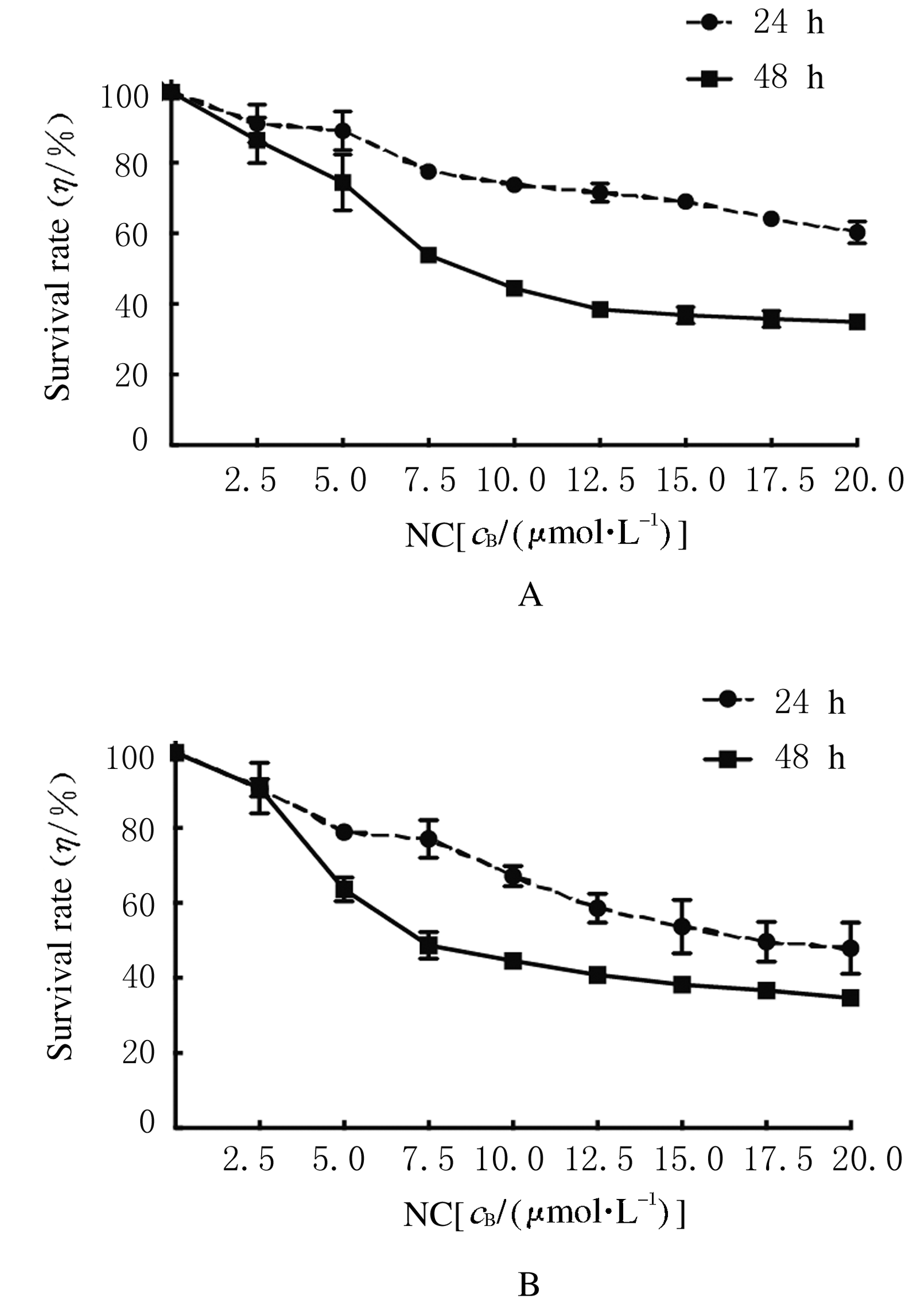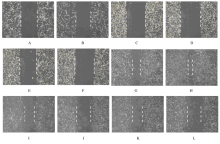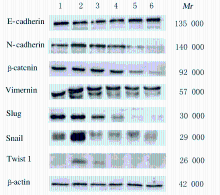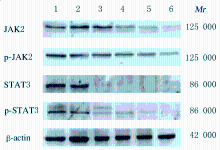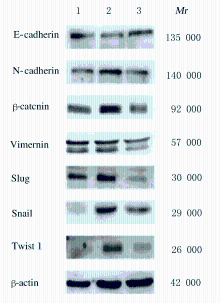Journal of Jilin University(Medicine Edition) ›› 2021, Vol. 47 ›› Issue (1): 73-81.doi: 10.13481/j.1671-587x.20210110
• Research in basic medicine • Previous Articles Next Articles
Inhibitory effect of nitidine chloride on epithelial-mesenchymal transition of glioma cells through JAK2/STAT3 signaling pathway
Mingbo JIA,Ying SUN,Ying WANG,Yanke SONG,Liyan ZHAO( )
)
- Department of Medical Laboratory,Second Hospital,Jilin University,Changchun 130041,China
-
Received:2020-06-20Online:2021-01-28Published:2021-01-27 -
Contact:Liyan ZHAO E-mail:970201043@qq.com
CLC Number:
- R739.41
Cite this article
Mingbo JIA,Ying SUN,Ying WANG,Yanke SONG,Liyan ZHAO. Inhibitory effect of nitidine chloride on epithelial-mesenchymal transition of glioma cells through JAK2/STAT3 signaling pathway[J].Journal of Jilin University(Medicine Edition), 2021, 47(1): 73-81.
share this article
Tab.1
Migration rates and invasion rates of glioma U87 cells in various groups (n=3,x±s,η/%)"
| Group | Migration rate | Invasion rate |
|---|---|---|
| Control | 53.384±0.993 | 100.000±0.000 |
| EMT | 71.588±1.005* | 150.594±7.209* |
| NC(μmol·L-1) | ||
| 2.5 | 19.951±2.086△ | 86.002±7.534△ |
| 5.0 | 18.122±1.505△ | 72.584±8.697△ |
| 7.5 | 12.722±1.528△ | 30.461±2.387△ |
| 10.0 | 13.265±0.617△ | 9.419±1.381△ |
Tab.2
Expression levels of EMT-related proteins in glioma U87 cellsin various groups"
| Group | E-cadherin | N-cadherin | β-catenin | Vimentin | Slug | Snail | Twist1 |
|---|---|---|---|---|---|---|---|
Control EMT NC(μmol·L-1) 2.5 5.0 7.5 10.0 | 1.00±0.00 0.78±0.04** 0.68±0.07 0.83±0.03 0.93±0.06△ 1.21±0.10△△ | 1.00±0.00 1.37±0.17* 1.38±0.11 1.12±0.16 0.52±0.14△△ 0.34±0.09△△ | 1.00±0.00 1.11±0.01** 1.13±0.11 0.84±0.08△△ 0.43±0.04△△ 0.24±0.06△△ | 1.00±0.00 1.37±0.09** 1.17±0.11 0.93±0.07△△ 0.68±0.07△△ 0.67±0.08△△ | 1.00±0.00 1.01±0.08 0.63±0.04△△ 0.49±0.08△△ 0.17±0.03△△ 0.14±0.04△△ | 1.00±0.00 1.97±0.20** 0.62±0.07△△ 0.62±0.04△△ 0.57±0.08△△ 0.52±0.06△△ | 1.00±0.00 2.04±0.19** 1.38±0.14△△ 0.70±0.06△△ 0.59±0.03△△ 0.59±0.03△△ |
Tab.3
Expression levels of JAK2, p-JAK2, STAT3 and p-STAT3 proteins in glioma U87 cells in various groups (n=3,x±s)"
| Group | JAK2 | p-JAK2 | STAT3 | p-STAT3 |
|---|---|---|---|---|
Control EMT NC(μmol·L-1) 2.5 5.0 7.5 10.0 | 1.00±0.00 1.13±0.09 1.06±0.10 0.75±0.04△ 0.49±0.03△ 0.35±0.04△ | 1.00±0.00 0.95±0.03 0.89±0.03 0.75±0.05△ 0.65±0.04△ 0.39±0.03△ | 1.00±0.00 0.92±0.04* 0.42±0.04△ 0.28±0.03△ 0.22±0.02△ 0.17±0.02△ | 1.00±0.00 0.96±0.02* 0.50±0.03△ 0.36±0.03△ 0.22±0.03△ 0.18±0.02△ |
Tab.4
Expression levels of EMT-related proteins in glioma U87 cells in various groups after treated with WP1066 ("
| Group | E-cadherin | N-cadherin | β-catenin | Vimentin | Slug | Snail | Twist1 |
|---|---|---|---|---|---|---|---|
Control EMT EMT+WP1066 | 1.00±0.00 0.47±0.05* 0.79±0.03△ | 1.00±0.00 1.57±0.06* 1.07±0.16△ | 1.00±0.00 1.29±0.04* 0.90±0.05△ | 1.00±0.00 1.25±0.07* 0.72±0.04△ | 1.00±0.00 1.43±0.08* 0.57±0.05△ | 1.00±0.00 2.29±0.10* 1.53±0.05Δ | 1.00±0.00 2.01±0.07* 0.87±0.06△ |
| 1 | KAHLERT U D, NIKKHAH G, MACIACZYK J. Epithelial-to-mesenchymal(-like)transition as a relevant molecular event in malignant gliomas[J]. Cancer Lett, 2013, 331(2): 131-138. |
| 2 | ISER I C, PEREIRA M B, LENZ G, et al. The epithelial-to-mesenchymal transition-like process in glioblastoma: an updated systematic review and in silico investigation[J]. Med Res Rev, 2017, 37(2): 271-313. |
| 3 | DESHPANDE R P, BABU P P. pDok2, caspase 3 dependent glioma cell growth arrest by nitidine chloride[J]. Pharmacol Rep, 2018, 70(1): 48-54. |
| 4 | CUI Y, WU L H, CAO R, et al. Antitumor functions and mechanisms of nitidine xhloride in human cancers[J]. J Cancer, 2020, 11(5): 1250-1256. |
| 5 | KIM H, KIM D, CHOI S A, et al. KDM3A histone demethylase functions as an essential factor for activation of JAK2-STAT3 signaling pathway[J]. Proc Natl Acad Sci U S A, 2018, 115(46): 11766-11771. |
| 6 | 刘丽敏, 刘华钢. 氯化两面针碱的抗肝癌活性及对DNA拓扑异构酶的影响[J]. 中国药理学通报, 2010, 26(4): 497-500. |
| 7 | 程翔宇. 氯化两面针碱对前列腺癌细胞抑制增殖、侵袭与诱发凋亡的研究[D].济南: 山东大学, 2015. |
| 8 | CHEN S P, YANG L, FENG J. Nitidine chloride inhibits proliferation and induces apoptosis in ovarian cancer cells by activating the Fas signalling pathway[J]. J PharmPharmacol, 2018, 70(6): 778-786. |
| 9 | 袁翠林, 娄 诤, 谢璐迪, 等. 氯化两面针碱对人食管癌Eca109细胞抑制作用及机制研究[J]. 中草药, 2019, 50(20): 4969-4973. |
| 10 | ALFONSO J C L, TALKENBERGER K, SEIFERT M, et al. The biology and mathematical modelling of glioma invasion: a review[J]. J R Soc Interface, 2017, 14(136): 20170490. |
| 11 | SONG Y, CHEN Y, LI Y Q, et al. Metformin inhibits TGF-β1-induced epithelial-to-mesenchymal transition-like process and stem-like properties in GBM via AKT/mTOR/ZEB1 pathway[J]. Oncotarget, 2018, 9(6): 7023-7035. |
| 12 | SONG Y, CHEN Y, LI Y Q, et al. Resveratrol suppresses epithelial-mesenchymal transition in GBM by regulating smad-dependent signaling[J]. Biomed Res Int, 2019, 2019: 1321973. |
| 13 | YEUNG K T,YANG J. Epithelial mesenchymal transition in tumor metastasis[J].Mol Oncol,2017,11(1):28-39. |
| 14 | ZHENG X F, CARSTENS J L, KIM J, et al. Epithelial-to-mesenchymal transition is dispensable for metastasis but induces chemoresistance in pancreatic cancer[J]. Nature, 2015, 527(7579): 525-530. |
| 15 | FISCHER K R, DURRANS A, LEE S, et al. Epithelial-to-mesenchymal transition is not required for lung metastasis but contributes to chemoresistance[J]. Nature, 2015, 527(7579): 472-476. |
| 16 | SUN M J, ZHANG N, WANG X L, et al. Hedgehog pathway is involved in nitidine chloride induced inhibition of epithelial-mesenchymal transition and cancer stem cells-like properties in breast cancer cells[J]. Cell Biosci, 2016, 6: 44. |
| 17 | CHENG Z X, GUO Y L, YANG Y B, et al. Nitidine chloride suppresses epithelial-to-mesenchymal transition in osteosarcoma cell migration and invasion through Akt/GSK-3β/Snail signaling pathway[J]. Oncol Rep, 2016, 36(2): 1023-1029. |
| 18 | FU X Q, CHOU J Y, LI T, et al. The JAK2/STAT3 pathway is involved in the anti-melanoma effects of atractylenolide I[J]. Exp Dermatol, 2018, 27(2): 201-204. |
| 19 | MA Y, ZHANG H, XIONG C, et al. CD146 mediates an E-cadherin-to-N-cadherin switch during TGF-β signaling-induced epithelial-mesenchymal transition[J]. Cancer Lett, 2018, 430: 201-214. |
| 20 | XIONG H, HONG J, DU W, et al. Roles of STAT3 and ZEB1 proteins in E-cadherin down-regulation and human colorectal cancer epithelial-mesenchymal transition[J]. J Biol Chem, 2012, 287(8): 5819-5832. |
| 21 | ZENG Y T, LIU X F, YANG W T, et al. REX1 promotes EMT-induced cell metastasis by activating the JAK2/STAT3-signaling pathway by targeting SOCS1 in cervical cancer[J]. Oncogene, 2019, 38(43): 6940-6957. |
| 22 | CHEN Y, SHAO Z, JIANG E H, et al. CCL21/CCR7 interaction promotes EMT and enhances the stemness of OSCC via a JAK2/STAT3 signaling pathway[J]. J Cell Physiol, 2020, 235(9): 5995-6009. |
| 23 | WANG L L, ZHANG F, CUI J Y, et al. CAFs enhance paclitaxel resistance by inducing EMT through the IL‑6/JAK2/STAT3 pathway[J]. Oncol Rep, 2018, 39(5): 2081-2090. |
| 24 | CHEN J, WANG J Q, LIN L, et al. Inhibition of STAT3 signaling pathway by nitidine chloride suppressed the angiogenesis and growth of human gastric cancer[J]. Mol Cancer Ther, 2012, 11(2): 277-287. |
| [1] | WEI Xujing, LI Lin, ZHANG Hongzhen, WANG Jing, XU Jing. Effects of LncRNA CCAT1 on proliferation,invasion and migration of endometrial cancer cells through TGF-β1/smad signaling pathway [J]. Journal of Jilin University(Medicine Edition), 2020, 46(05): 1016-1022. |
| [2] | ZHOU Ning, WU Rui, MA Zhenkai, CHEN Weiwei, LI Xuelin, GONG Kaikai, YANG Lijuan, DAI Juanjuan, WU Yan. Effects of down-regulation of ADAR1 expression on proliferation, migration and epithelial-mesenchymal transition of human lung cancer cells [J]. Journal of Jilin University(Medicine Edition), 2020, 46(04): 669-674. |
| [3] | DONG Zhuo, LI Jiale, CHEN Xiaoyi, WANG Rui, YI Junxuan, WEI Xinfeng, JIN Shunzi. Effect of NRP1 gene knockout on process of radiation-induced pulmonary fibrosis and its mechanism [J]. Journal of Jilin University(Medicine Edition), 2020, 46(01): 26-34. |
| [4] | WANG Xinmeng, LI Qiyang, LIU Chao, XIAO Jianying. Effects of microspherule protein 1 on invasion and migration of gastric cancer cells and their mechanisms [J]. Journal of Jilin University(Medicine Edition), 2019, 45(02): 251-257. |
| [5] | DENG Haiyue, YU Fang, JIANG Hong. Regulatory effect of direct renin inhibitor aliskiren on epithelial-mesenchymal transition of renal fibrosis mice [J]. Journal of Jilin University Medicine Edition, 2017, 43(01): 16-20. |
| [6] | CHEN Xue, ZHANG Yuying, SHAO Yu, ZHANG Luni, NING Mingjie, TANG Ying, QI Ling, LI Yunqian. Inhibitory effect of deoxyschizandrin on growth of brain glioma cells and its mechanism [J]. Journal of Jilin University Medicine Edition, 2016, 42(04): 711-715. |
| [7] | ZHAO Yan, LIN Tianyu, SUN Ru, HAN Yanlong, MI Donghui, ZENG Xianlu, BA Xueqing. Ameliorative effect of PARP1 inhibition on bleomycin- induced pulmonary fibrosis [J]. Journal of Jilin University Medicine Edition, 2015, 41(03): 442-447. |
| [8] | QI Ling,WANG Shuang,WEN Na,JING Peng-yan,JIN Hong,WANG Wei-yao,CAO Zhi-you. Inhibitory effect of Rhizoma typhonii extract on growth of glioma cells and its mechanism [J]. Journal of Jilin University Medicine Edition, 2014, 40(04): 768-771. |
| [9] | SHI Yi,WU Wei-zhong,JIN Xiao-hong, ZHANG Bin . Expressions of α-catulin and E-cadherin in tongue squamous cell carcinoma tissue and clinical significance [J]. Journal of Jilin University Medicine Edition, 2014, 40(04): 838-841. |
| [10] | CAO Zhi-you,JIN Hong,TIAN Jing,WANG Shuang,QI Ling,LI Yun-qian. Proliferation inhibition and inducing apoptosis of Rhizoma Typhonii extracts on glioma cells and their mechanisms [J]. Journal of Jilin University Medicine Edition, 2013, 39(4): 649-652. |
| [11] | XU Jun-jie,U Hong-quan,ZHAO Wei,JIN Hong,WEN Na,QI Ling,LIU Xing-ji. Induction of broccoli polypeptide on apoptosis of C6 glioma cells [J]. Journal of Jilin University Medicine Edition, 2013, 39(1): 8-11. |
| [12] | GUO Ting-ting,ZHANG Bin,LIU Jia-bai,LIU Shuo-shuo,DONG Xiao-ting. Influence of PTEN in invasion and expression of epithelial-mesenchymal transition related protein in tongue squamous cell car cinoma [J]. Journal of Jilin University Medicine Edition, 2013, 39(1): 70-73. |
| [13] | SHANG Jing,FANG Ning|TENG Si-ying|CUI Xiang-yan|WANG Xin. Expressions of Snail and E-cadherin in laryngeal squamous cell carcinoma tissues and their significances [J]. J4, 2012, 38(2): 315-319. |
| [14] | ZHANG Shi, ZHANG Yue, BI Xiao-Ying, LI Zhi-Chao. Inhibitory effect of triethyltin chloride on proliferation of |rat C6 glioma cells in vitro [J]. J4, 2009, 35(4): 595-598. |
| [15] | CHI Xiu-mei,ZHANG Ji-zhou,KAN Mu-jie,HONG Min. Effect of heroin on gene expression of PCNA in C6 glioma cells [J]. J4, 2008, 34(6): 949-951. |

